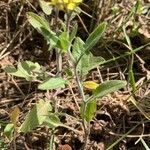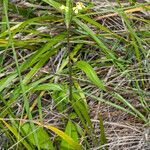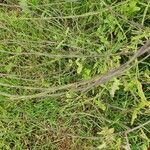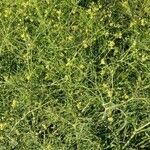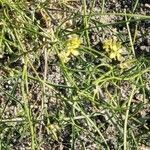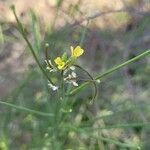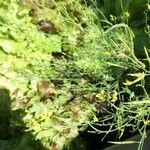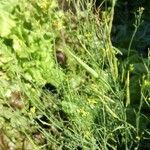Annuals; glabrous or pubescent. Stems erect, branched distally, (1-)2-7(-8.5) dm, sparsely to densely (soft) pubescent at least basally, usually glabrous distally. Basal leaves rosulate; petiole (1-)2-5(-9) cm; blade broadly oblanceolate to oblong-oblanceolate (in outline), 3-8 (-10) cm × (10-)20-40(-60) mm, margins runcinate-pinnatipartite; lobes 2-5 on each side, oblong or lanceolate, much smaller than terminal lobe, margins subentire or dentate, (terminal lobe lanceolate, deltate, or often hastate). Cauline leaves similar to basal; (distalmost) blade with 1 or 2 lobes on each side, much smaller than terminal lobe, (terminal lobe narrowly lanceolate, linear, or hastate). Fruiting pedicels ascending to subdivaricate, stout, nearly as wide as fruit, 3-6 mm. Flowers: sepals ascending, oblong, 3.5-5.5 × 1-2 mm; petals spatulate, (6-)7-9(-10) × 2.5-4 mm, claw 3-5.5 mm; filaments (4-)5-8 mm; anthers oblong, 1-1.8 mm. Fruits narrowly linear, straight, smooth, stout, (5-)6-10 (-13) cm × 1-1.5 mm; valves glabrous or pubescent; ovules (60-)80-100(-140) per ovary; style (subclavate), 1-3(-4) mm; stigma prominently 2-lobed. Seeds 1-1.5 × 0.7-0.9 mm. 2n = 14.
Annual or biennial herbs up to 1 m tall, branched. Stems softly puberulous, densely in the lower part, thinly in the upper part. Basal leaves rosulate, petiolate, pinnatisect, 4-5-jugate, the lateral lobes opposite or alternate, ± triangular or semi-ovate-triangular, subentire or remotely denticulate; terminal lobe triangular-ovate, obscurely 3-lobate, obtuse, remotely denticulate. Stem leaves 1-3-jugate with both the terminal and the lateral lobes becoming narrower and longer, the terminal lobe hastate; upper stem leaves hastately 3-lobed, the two lateral lobes getting progressively smaller; uppermost leaves lanceolate, entire; all leaves softly puberulous, ciliolate. Racemes terminal, at first dense, corymbose; in fruit elongate, lax. Sepals 3.5-5 mm long, thinly puberulous. Petals 7-8 mm long, broadly oblanceolate, with a long narrow claw, yellow. Siliquae 5-8.5 cm long, 1.2-1.5 mm in diameter, linear, terete; valves 3-nerved, puberulous in the lower part only; style 1-3 mm long, clavate-cylindrical. Seeds c. 1 x 0-7 mm, ovoid, brown.
Annual herb. Stems erect, softly hairy, to 1 m tall. Lvs sparsely to densely hairy. Rosette and lower stem lvs lyrate-pinnatifid or pinnatifid to almost lyrate-pinnate, 5-10-(30) × (1)-2-8-(15) cm; terminal lobe ovate to triangular to hastate; lateral lobes in 1-5 pairs, narrow-lanceolate or triangular, entire, sinuate or coarsely toothed. Upper stem lvs usually smaller with narrower, but not linear-filiform lobes, or hastate, or ovate and not lobed. Racemes often flexuous, ebracteate, glabrous or sparsely hairy, 20-40-(60) cm long. Pedicels 3-5 mm long, elongating to c. 10 mm long at fruiting, sparsely hairy. Sepals usually hairy, 3-5 mm long, not horned. Petals yellow, 6-10 mm long. Anthers 1-1.5 mm long; filaments > sepals. Silique glabrous or hairy, spreading, linear-cylindric, (40)-60-100 × 1-1.5 mm; style 0.5-2 mm long. Seeds oblong, brown, c. 1 mm long.
Annual herb up to 60 cm. high, ± hairy with simple soft hairs especially on basal parts.. Stems erect, much branched.. Rosette leaves pinnatipartite, with up to 4 pairs of lateral lobes, evanescent; cauline leaves pinnatipartite to pinnatisect, 0–4 pairs of narrow acute lateral lobes and acutely to hastately triangular, or upwards, narrowly hastate to lanceolate terminal lobe.. Racemes with numerous small flowers, in fruit elongate, rather lax; pedicels spreading with ± ascending siliquae, 3–6 mm. long, ± as broad as the siliqua.. Sepals oblong, hairy, 3–5 mm. long.. Petals pale yellow, clawed, with a narrowly obovate limb, 7–10 mm. long.. Siliqua linear, terete, straight or slightly curved, 30–100 mm. long, ± 1 mm. broad; valves sparsely hairy, thick and firm.. Seeds red-brown, oblong, ± 1 mm. long and 0.7 mm. broad, very finely reticulate.
Annual or biennial herb, 0.3-1.0 m high, branched. Stems puberulous. Leaves: basal leaves rosulate, petiolate, pinnatisect, 4-or 5-jugate, lateral lobes opposite or alternate, triangular or semi-ovate-triangular, subentire denticulate, terminal lobe triangular-ovate, 3-lobed, denticulate; cauline leaves 1-3-jugate, puberulous, terminal and lateral lobes become narrower and longer, terminal lobe hastate, upper ones hastately 3-lobed, lateral lobes progressively smaller, uppermost leaves lanceolate, entire. Inflorescence a terminal raceme. Sepals puberulous. Petals oblanceolate, clawed, yellow. Fruit a linear siliqua, terete. Seeds ovoid, brown.
Annual or biennial herb, up to 1 m high; hairs simple. Stems erect; densely hairy in lower part, thinly in upper. Leaves basally rosulate, petiolate, pinnatisect, 4-or 5-jugate, lateral lobes ± triangular, entire or dentate, terminal lobe triangular-ovate, apex obtuse; stem leaves smaller, upper leaves narrowly ovate, margins entire; all leaves softly puberulous, ciliolate. Flowers: in terminal racemes, at first dense, lax in fruit, ebracteate; petals obovate, 7-8 mm long, claw long, yellow; May.-Aug. Fruit with siliquae linear, terete, 50-85 x 1.2-1.5 mm, puberulous in lower half only.
Annual or biennial herb 25–90 cm high, erect, vestured; hairs short, soft, reflexed. Rosette leaves pinnatifid with 4 pairs of broadly triangular lobes, petiolate, not persistent; cauline leaves reducing, saggitate, hastate, to lanceolate, entire. Inflorescence an ebracteate raceme. Sepals erect, 4–5 mm long, hispid. Petals 6–10 mm long, pale yellow. Style clavate, the apex as wide as siliqua, 1–3.5 mm long. Siliqua 4–10 cm long, 1–2 mm wide, terete, straight, thick-walled; pedicels spreading, 3–10 mm long. Seeds narrowly ovoid, c. 1 mm long.
Annual or perennial herb, up to 1 m tall, stems pubescent with simple hairs, especially basally. Leaves in a basal rosette, pinnatisect, in 4 or 5 pairs of lobes, upper ones fewer-lobed with terminal lobe spearhead-shaped. Flowers yellow. Fruit linear, terete, 50-85 x 1.2-1.5 mm.
A cabbage family herb. It grows each year from seed. It grows 80 cm tall. It is hairy. The lower leaves have lobes pointing out from the midrib. The upper leaves do not have lobes or can have 3 lobes. The flowers are pale yellow and 5-8 mm across. The seed pods are 5-10 cm long.
Annual or biennial herb, up to 1 m high, with simple hairs. Inflorescence ebracteate. Siliqua linear, terete, 50-85 x 1.2-1.5 mm, puberulous in lower half only. Flowers yellow.
Basal leaves in a rosette, long-stalked, lyrate-pinnatipartite or pinnate, appressed-pilose; stem leaves with hastate terminal lobe; uppermost leaves hastate or lanceolate.
Annual or biennial herb up to 1 m. tall, stems with short, weak, patent or downward-pointing hairs.
Silique 4–10 cm. x 1–2 mm., obliquely erect with pedicels 3–7 mm. long, valves 3-nerved.
Flowers pale yellow, pedicellate, pedicel 4–7 mm. long, in ebracteate racemes.
Seeds 0.6–1 x 0.5 mm., ellipsoid or narrowly ovoid, yellowish-brown.
Sepals 4–5 x 1 mm., erect, oblong.
Stamens very unequal in length.
Petals 5–8 mm. long, obovate.
